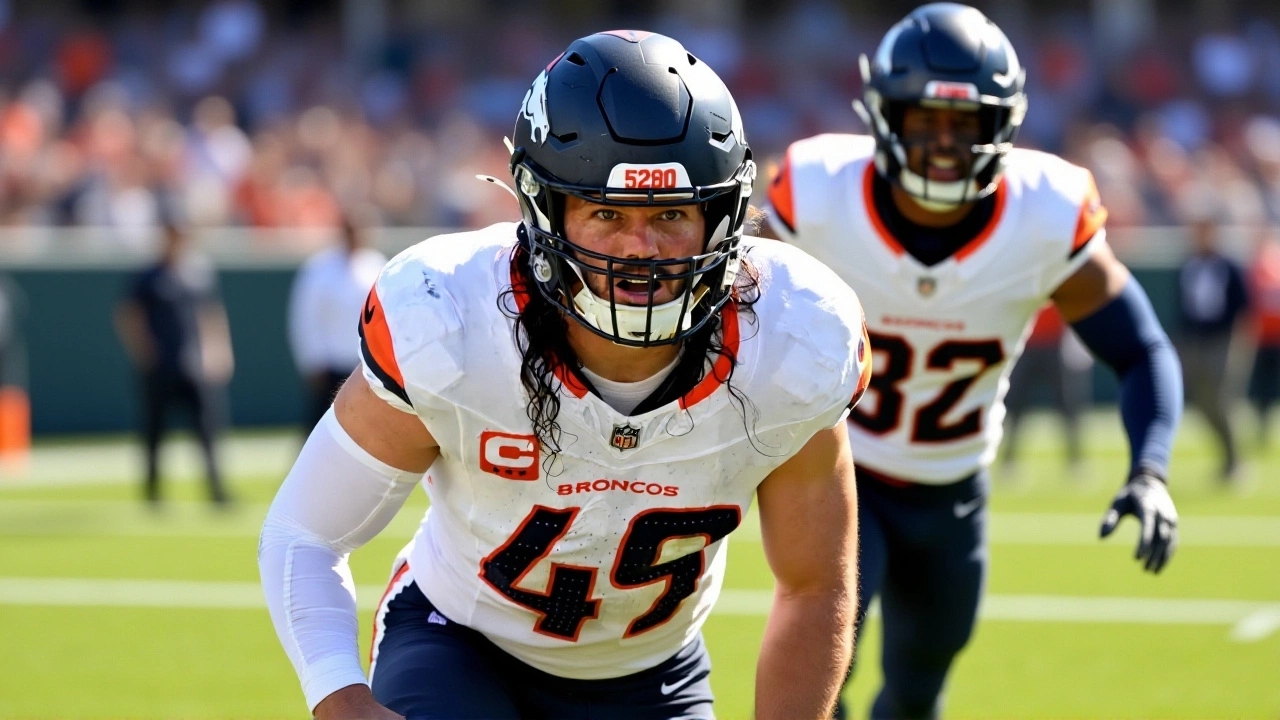When Bo Nix stepped up to the mic at the Denver Broncos’ training facility on October 29, 2025, he didn’t sugarcoat it. The 24-year-old quarterback, fresh off a four-touchdown performance against the Chargers, looked weary—not from fatigue, but from the realization that the Houston Texans defense was something else entirely. "They fly around," he said, voice low but steady. "They do a really good job of attacking the football, making tackles in space. Fast-flowing defense." It wasn’t hype. It was a warning. And four days later, at NRG Stadium in Houston, Texas, the Broncos found out just how true that was.
The Defense That Doesn’t Bluff
The Houston Texans aren’t flashy. They don’t blitz often—just 21.1% of the time, one of the lowest rates in the league. They don’t try to trick you with exotic schemes. What they do, they do with surgical precision. Through Week 8 of the 2025 season, they led the NFL in scoring defense at 14.3 points per game. Only seven teams allowed fewer than 5.0 yards per play. The Texans? They were at 4.8. Third-down conversions? They held opponents to 32.1%, top-three in the league. Time of possession? Averaging 33 minutes and 45 seconds per game, they were wearing teams down before halftime."They don’t do a whole lot, but they do what they do really well," Nix said. And that’s the scary part. No gimmicks. No overcomplicating. Just disciplined gap control, relentless pursuit, and elite tackling in open space. Jalen Pitre, the nickel safety, was his go-to name. "This nickel’s a great player," Nix said, emphasizing Pitre’s range and instincts. He also singled out cornerbacks Derek Stingley Jr. and Kamari Lassiter—both young, both physical, both unafraid to meet receivers at the line.
And behind it all? DeMeco Ryans. The Texans’ head coach, a former All-Pro linebacker, put his fingerprints all over the unit. No fancy terminology. No gimmicks. Just football. Hard-nosed, physical, and unrelenting.
Why the Broncos Had to Change Their Approach
Nix’s numbers against the blitz were elite—78.4% completion rate, 9.3 yards per attempt, 112.7 passer rating. But the Texans weren’t going to give him that luxury. They’d rather hold the line, force him into rhythm throws, and trust their secondary to make plays on the ball. The Broncos had scored more than 21 points in only two of their last six games. Nix himself had thrown for 465 yards and eight total touchdowns in that span, but the offense was inconsistent. They needed to move the chains. They needed to sustain drives. They needed to grind."We gotta execute at a higher level," Nix told reporters. "They’re not gonna give us much." And they didn’t.
For three quarters in Houston, the Broncos were stuck in neutral. The Texans’ defense held them to a field goal in the red zone. They forced a three-and-out on Denver’s first drive of the second half. The scoreboard read 17-10, Houston. The crowd was loud. The Broncos’ offense looked rattled.
The Comeback That Proved Something
Then, with 8:12 left in the fourth, everything changed. A 14-play, 78-yard drive—seven of those plays were runs. Nix handed off to Javonte Williams three times in a row. Then a 12-yard slant to Courtland Sutton. A 17-yard scramble on third-and-8. And finally, a 1-yard plunge by Williams to tie the game at 20-20.The Texans responded with a quick three-and-out. The Broncos got the ball back with 1:49 left. No timeouts. 47 yards to go. Nix completed a 15-yard pass to Montrell Washington. A 12-yard run by Williams. Then, on third-and-7, a quick slant to Jerry Jeudy—covered tightly, but he fought for every inch. First down. The clock ticked under 30 seconds. The field goal unit trotted on. Brandon McManus, 48 yards out, under pressure, in a dome, with the season on the line…
And it was good.
23-20. Broncos win. Walk-off. No drama. Just execution.
What Nix Said After the Win
The next day, in a quiet locker room still buzzing with adrenaline, Nix didn’t gloat. He didn’t take credit. He just said: "We just did enough." Then, with a small smile: "It proves we can win tough games." That’s the quiet truth. The Texans’ defense lived up to every bit of hype. They didn’t break. They didn’t crack. They just made the Broncos earn it. And when the Broncos finally did—through discipline, patience, and a little bit of guts—they showed they belonged in the same conversation as the league’s elite.Behind the Numbers: Why the Texans Are So Good
Let’s break it down:- 14.3 points allowed per game — best in NFL
- 4.8 yards per play allowed — one of only seven teams under 5.0
- 32.1% third-down conversion rate — top 3 in the league
- 33:45 average time of possession — top 3
- 21.1% blitz rate — bottom half of NFL
They don’t need to blitz. They don’t need to gamble. They just need to be right. And they almost always are.
It’s like a chess match where the Texans only move pawns—but every pawn is a knight in disguise.
What’s Next for Both Teams?
For the Broncos, this win isn’t just about a playoff push. It’s about identity. They’ve been a team that wins when the offense explodes. Now, they’ve proven they can win when the offense struggles—and the defense has to carry them. Nix is growing into a leader who thrives under pressure.For the Texans? They’re not just good. They’re building something sustainable. With Ryans at the helm and a core of young, hungry defenders like Pitre and Lassiter, this defense could be the foundation of a championship-caliber team for years. The only question now: Can their offense keep up?
Frequently Asked Questions
How did Bo Nix’s performance against the Texans compare to his previous games?
Nix threw for 242 yards and two touchdowns with no interceptions against the Texans, his lowest yardage total in six weeks—but he also rushed for 38 yards and led a game-winning drive under pressure. His passer rating (98.4) was below his season average (103.1), yet his efficiency in critical moments was elite. He converted 8 of 12 third downs on the final drive alone, showing growth in clutch situations.
Why is the Texans’ low blitz rate so effective?
By blitzing less than 22% of the time, the Texans force offenses to believe they’re playing man coverage or zone. That hesitation creates hesitation in the quarterback’s decision-making. With elite secondary play from Pitre, Stingley, and Lassiter, the Texans don’t need extra rushers—they just need their defensive line to hold blocks and their backs to read routes. It’s a high-risk, low-reward strategy for offenses.
What makes Jalen Pitre such a standout defender?
Pitre recorded 5 interceptions and 14 passes defended in 2025, but his real value is in his awareness. He’s the only safety in the NFL with more than 30 tackles in the box and 10+ tackles in coverage this season. He reads quarterbacks like a book, often shifting pre-snap to disguise coverage. Nix called him "the engine" of the defense—not because he hits hardest, but because he makes everyone else better.
How does the Texans’ defense compare to other top units in recent NFL history?
The 2025 Texans are statistically similar to the 2019 Baltimore Ravens and the 2023 Buffalo Bills—top-three in scoring defense, low yards per play, and elite third-down stops. But unlike those teams, they don’t rely on star pass rushers. Instead, they’re built like the 2008 Pittsburgh Steelers: disciplined, gap-sound, and suffocating in the red zone. Their consistency over 16 games is what sets them apart.
What’s the biggest challenge for the Broncos moving forward?
The Broncos now face a schedule with four of their next five opponents ranked in the top 10 in defensive efficiency. Their ability to sustain drives without explosive plays will be tested again. If they can replicate the Houston game plan—control the clock, minimize mistakes, and let the defense dictate tempo—they’ll be a legitimate playoff threat. But one win doesn’t fix inconsistency.
Did the Texans’ defense show any weaknesses during the game?
They did. On two occasions in the fourth quarter, the Texans’ linebackers bit hard on play-action fakes, leaving deep seams open. Nix targeted those gaps twice—once for a 24-yard completion to Sutton. But those were rare. The Texans’ defensive line also showed minor fatigue in the final minutes, allowing two 5+ yard runs on critical downs. Still, they held when it mattered most.

